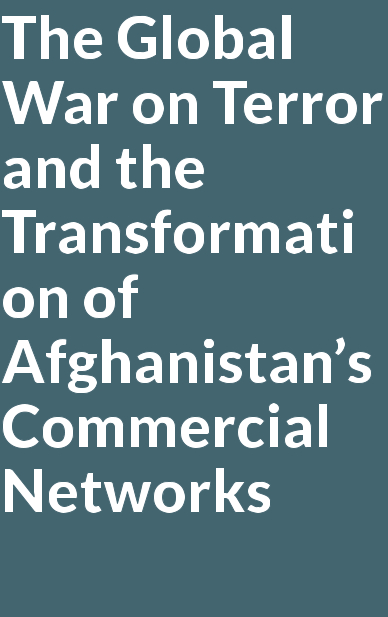

© 2023-2024 Oriental Institute, The Czech Academy of Sciences, Kevin L. Schwartz, and Ameem Lutfi


Discussions
on
the
role
played
by
regional
connectivity
in
the
economic
development
of
countries
along
the
so-called
“Silk
Road”
reached
a
fever
pitch
during
the
twenty
year
Global
War
on
Terror
(GWOT).
The
same
period,
however,
saw
increasing
attempts
to
rigidify
national
borders
and
restrict
mobility
across
them.
These
paradoxes
shaped
local
experiences
of
mobility
in
the
borderlands
of
South
and
Central
Asia
during
the
years
of
the
GWOT
and
are
continuing
to have profound effects on the social, economic and political dynamics of this complex transregional arena.
As
the
attacks
on
the
twin
towers
in
New
York
and
the
Pentagon
in
Washington
DC
unfolded,
I
was
drinking
tea
with
a
Shiʿi
Ismaili
family
in
a
village
in
the
mountainous
Chitral
region
of
northern
Pakistan
.
The
bazaar
nearby
was
as
busy
as
usual.
In
the
1990s,
butchers,
bakers
and
money
dealers
from
northern
Afghanistan
had
done
a
brisk
business
with
local
villagers
in
bazaars
across
the
region;
men
from
Tajikistan
laboured
in
the
village’s
rice
fields.
Movements
of
people
(refugees,
labourers,
and
fighters) and commodities (especially lapis and animals) closely
connected neighbouring regions of Afghanistan, Tajikistan, and Pakistan
and brought societies into proximity with one another.
The
Global
War
on
Terror
imposed
restrictions
on
such
forms
of
transregional
mobility
and
the
forms
of
social
interactions
with
which
they
were
enlaced.
States
across
the
region
increasingly
depicted
cross-border
activities
as
a
security
risk
and
depicted
mobile
persons
as
threatening.
Projects
of
“border
security”
-
often
supported
by
international
organisations
-
were
ubiquitous.
A
fence
was
constructed
along
parts
of
the
Afghanistan
and
Pakistan
boundary
.
“Border
markets”
were
opened
at
various
points
along
the
border
of
Afghanistan
and
Tajikistan
in
order
to
enable
cross-border
trade
and
social
exchange
yet
only
under
the
watchful
eye
of
officials.
All
the
while,
militants
active
in
the
Taliban’s
war
against
the
NATO-supported
government
in
Kabul
found
their
way
across
mountain
passes,
often
paying
local
strongmen
in
northern
Afghanistan
taxes
for
the
ability
of
doing
so.
Fixed
and
rigid
borders
coexisted
with
more
localized
forms
of
control
over territory in a manner reminiscent of the
hybrid forms of government
important for life in the region from the colonial era onwards.
While
restrictive
border
policies
constrained
regional
mobility,
major
powers
paradoxically
promoted
ambitious
“regional
connectivity”
projects
in
the
same
period
as
an
economic
panacea,
reflecting
the
competing
impulses
shaping
the
GWOT
era.
Cross-border
trade
facilitated
by
improved
infrastructures
was
presented
locally
and
internationally
as
the
solution
to
Afghanistan’s
instability,
an
idea
embraced
by
local
elites
including
President
Ashraf
Ghani.
Formal
projects
of
“regional
connectivity”
-
from
Hilary
Clinton’s
“the
New
Silk
Road”
to
China’s
“Belt
and
Road
Initiative” - promoting infrastructural development and “people to people exchange” flourished in the neoliberal environment fashioned by the GWOT.
People
living
across
the
region
experienced
these
paradoxical
policy
developments
in
contrasting
ways.
Villagers
living
on
neighbouring
sides
of
colonial-era
borders
found
it
increasingly
difficult
to
meet
one
another
and
maintain
kin
ties.
Yet
traders
in
a
hot
seat
of
the
GWOT
-
Afghanistan
-
benefitted
from
a
massive
influx
of
foreign
capital
into
Kabul.
Transporters
moved
truckloads
of
construction
materials
and
fruits
between
Iran,
Central
Asia’s
post-Soviet
successor
states,
and
Pakistan
.
Infrastructural
developments
-
bridges,
new
and
old
-
eased
the
work
of
transnational
nexuses of transporters, government officials, local strongmen, armed militants and smugglers who moved the fuel and shipped the hardware of the GWOT.
Economic
activities
such
as
these
had
important
social
implications.
Increasingly
capitalized
Afghan
commercial
networks
extended
their
reach,
economically,
socially,
and
geographically
and
in
the
process
forged
new
markets
and
scales
of
regional
connections.
Doing
business
with
Central
Asia,
for
example,
required
Afghan
traders
to
find
trustable
local
partners.
Afghans
had
lived
as
exiles
and
used
trade
as
a
survival
strategy
across
the
Central
Asian
Republics
since
the
collapse
of
both
Afghanistan
and
the
Soviet
Union
in
1992.
After
2001,
having
knowledge
of
local
conditions and state structures, small-scale market traders from Afghanistan living in Central Asia became important middlemen between Afghan merchants and local state officials.
Afghanistan’s
merchants
successfully
managed
flows
of
capital,
commodities,
and
commercial
personnel
along
increasingly
complex
routes.
Wholesale
markets
in
Moscow
and
St.
Petersburg,
Kyiv
and
Odesa,
and
Minsk
and
Almaty
were
the
nodes
of
a
thriving
range
of
networks
comprising
Afghan
traders,
exiles,
and
refugees.
Commercial
centres
such
as
the
“international
trade
city”
of
Yiwu
in
China
saw
Afghan
merchants
open
trading
offices
that
sent
commodities
across
the
world
and
invest
capital
available
to
them
in
restaurants,
hotels
and
leisure
facilities.
In
the
Arabian Gulf, Afghan merchants emerged as major players in the import-export trade, as well as a range of business activities widely held to be related to money laundering.
The
fragile
political
situation
in
Afghanistan
alongside
the
increasing
intensity
of
conflict
between
the
country’s
government
and
the
Taliban
meant
that
the
country’s
savvy
merchants
as
well
as
the
government
officials
with
whom
they
worked
invested
in
homes,
permits
and
passports
in
countries
whose
authorities
also
had
a
keen
eye
for
GWOT
cash.
Citizens
of
Afghanistan
ranked
alongside
those
of
Iraq
in
the
list
of
the
most
numerous
foreign
buyers
of
property
in
Turkey
,
for
example.
By
2021,
Dubai
and
Istanbul,
rather
than
Peshawar
or
Mashhad,
let
alone
Chitral
and
Khorog, were the cities in which Afghanistan’s merchants opened offices, bought property, and stationed their families.
The
Global
War
on
Terror
transformed
the
socio-commercial
geographies
of
intersecting
regions
of
Central,
South
and
West
Asia.
The
concurrent
flows
of
capital
and
processes
of
bordering
brought
some
previously
distant
regions
closer
to
one
another
as
they
created
a
distance
between
neighbours.
The
GWOT
narrowed
the
scope
of
human
mobility
across
historically
connected
and
adjacent
regions
of
South,
Central
and
West
Asia
in
major
ways.
As
a
result,
the
prolonged
war
has
reduced
the
potential
for
social,
cultural
and
economic
interpenetrations
across
national
borders
and
thereby
furnished
the
ground
for
further
inter-regional
tensions
and
conflicts,
at
both
the
local
and
national
levels.
All
this
is
a
far
cry
from
the
promise
of
improved
connectivity
and regional prosperity made during the GWOT.







If you are interested in contributing an article for
the project, please send a short summary of the
proposed topic (no more than 200 words) and brief
bio to submissions@911legacies.com. For all
other matters, please contact
inquiry@911legacies.com.

CONTACT


Discussions
on
the
role
played
by
regional
connectivity
in
the
economic
development
of
countries
along
the
so-called
“Silk
Road”
reached
a
fever
pitch
during
the
twenty
year
Global
War
on
Terror
(GWOT).
The
same
period,
however,
saw
increasing
attempts
to
rigidify
national
borders
and
restrict
mobility
across
them.
These
paradoxes
shaped
local
experiences
of
mobility
in
the
borderlands
of
South
and
Central
Asia
during
the
years
of
the
GWOT
and
are
continuing
to
have
profound
effects
on
the
social,
economic
and
political
dynamics
of
this
complex transregional arena.
As
the
attacks
on
the
twin
towers
in
New
York
and
the
Pentagon
in
Washington
DC
unfolded,
I
was
drinking
tea
with
a
Shiʿi
Ismaili
family
in
a
village
in
the
mountainous
Chitral
region
of
northern
Pakistan
.
The
bazaar
nearby
was
as
busy
as
usual.
In
the
1990s,
butchers,
bakers
and
money
dealers
from
northern
Afghanistan
had
done
a
brisk
business
with
local
villagers
in
bazaars
across
the
region;
men
from
Tajikistan
laboured
in
the
village’s
rice
fields.
Movements
of
people
(refugees,
labourers,
and
fighters)
and
commodities
(especially
lapis
and
animals)
closely
connected
neighbouring
regions
of
Afghanistan,
Tajikistan,
and
Pakistan
and
brought
societies into proximity with one another.
The
Global
War
on
Terror
imposed
restrictions
on
such
forms
of
transregional
mobility
and
the
forms
of
social
interactions
with
which
they
were
enlaced.
States
across
the
region
increasingly
depicted
cross-border
activities
as
a
security
risk
and
depicted
mobile
persons
as
threatening.
Projects
of
“border
security”
-
often
supported
by
international
organisations
-
were
ubiquitous.
A
fence
was
constructed
along
parts
of
the
Afghanistan
and
Pakistan
boundary
.
“Border
markets”
were
opened
at
various
points
along
the
border
of
Afghanistan
and
Tajikistan
in
order
to
enable
cross-border
trade
and
social
exchange
yet
only
under
the
watchful
eye
of
officials.
All
the
while,
militants
active
in
the
Taliban’s
war
against
the
NATO-supported
government
in
Kabul
found
their
way
across
mountain
passes,
often
paying
local
strongmen
in
northern
Afghanistan
taxes
for
the
ability
of
doing
so.
Fixed
and
rigid
borders
coexisted
with
more
localized
forms
of
control
over
territory
in
a
manner
reminiscent
of
the
hybrid
forms
of
government
important
for
life
in
the
region
from
the colonial era onwards.
While
restrictive
border
policies
constrained
regional
mobility,
major
powers
paradoxically
promoted
ambitious
“regional
connectivity”
projects
in
the
same
period
as
an
economic
panacea,
reflecting
the
competing
impulses
shaping
the
GWOT
era.
Cross-border
trade
facilitated
by
improved
infrastructures
was
presented
locally
and
internationally
as
the
solution
to
Afghanistan’s
instability,
an
idea
embraced
by
local
elites
including
President
Ashraf
Ghani.
Formal
projects
of
“regional
connectivity”
-
from
Hilary
Clinton’s
“the
New
Silk
Road”
to
China’s
“Belt
and
Road
Initiative”
-
promoting
infrastructural
development
and
“people
to
people
exchange”
flourished
in
the
neoliberal environment fashioned by the GWOT.
People
living
across
the
region
experienced
these
paradoxical
policy
developments
in
contrasting
ways.
Villagers
living
on
neighbouring
sides
of
colonial-era
borders
found
it
increasingly
difficult
to
meet
one
another
and
maintain
kin
ties.
Yet
traders
in
a
hot
seat
of
the
GWOT
-
Afghanistan
-
benefitted
from
a
massive
influx
of
foreign
capital
into
Kabul.
Transporters
moved
truckloads
of
construction
materials
and
fruits
between
Iran,
Central
Asia’s
post-Soviet
successor
states,
and
Pakistan
.
Infrastructural
developments
-
bridges,
new
and
old
-
eased
the
work
of
transnational
nexuses
of
transporters,
government
officials,
local
strongmen,
armed
militants
and
smugglers
who
moved
the
fuel
and
shipped the hardware of the GWOT.
Economic
activities
such
as
these
had
important
social
implications.
Increasingly
capitalized
Afghan
commercial
networks
extended
their
reach,
economically,
socially,
and
geographically
and
in
the
process
forged
new
markets
and
scales
of
regional
connections.
Doing
business
with
Central
Asia,
for
example,
required
Afghan
traders
to
find
trustable
local
partners.
Afghans
had
lived
as
exiles
and
used
trade
as
a
survival
strategy
across
the
Central
Asian
Republics
since
the
collapse
of
both
Afghanistan
and
the
Soviet
Union
in
1992.
After
2001,
having
knowledge
of
local
conditions
and
state
structures,
small-scale
market
traders
from
Afghanistan
living
in
Central
Asia
became
important
middlemen
between
Afghan merchants and local state officials.
Afghanistan’s
merchants
successfully
managed
flows
of
capital,
commodities,
and
commercial
personnel
along
increasingly
complex
routes.
Wholesale
markets
in
Moscow
and
St.
Petersburg,
Kyiv
and
Odesa,
and
Minsk
and
Almaty
were
the
nodes
of
a
thriving
range
of
networks
comprising
Afghan
traders,
exiles,
and
refugees.
Commercial
centres
such
as
the
“international
trade
city”
of
Yiwu
in
China
saw
Afghan
merchants
open
trading
offices
that
sent
commodities
across
the
world
and
invest
capital
available
to
them
in
restaurants,
hotels
and
leisure
facilities.
In
the
Arabian
Gulf,
Afghan
merchants
emerged
as
major
players
in
the
import-export
trade,
as
well
as
a
range
of
business
activities
widely
held
to
be
related
to
money laundering.
The
fragile
political
situation
in
Afghanistan
alongside
the
increasing
intensity
of
conflict
between
the
country’s
government
and
the
Taliban
meant
that
the
country’s
savvy
merchants
as
well
as
the
government
officials
with
whom
they
worked
invested
in
homes,
permits
and
passports
in
countries
whose
authorities
also
had
a
keen
eye
for
GWOT
cash.
Citizens
of
Afghanistan
ranked
alongside
those
of
Iraq
in
the
list
of
the
most
numerous
foreign
buyers
of
property
in
Turkey
,
for
example.
By
2021,
Dubai
and
Istanbul,
rather
than
Peshawar
or
Mashhad,
let
alone
Chitral
and
Khorog,
were
the
cities
in
which
Afghanistan’s
merchants
opened
offices,
bought
property,
and
stationed
their families.
The
Global
War
on
Terror
transformed
the
socio-
commercial
geographies
of
intersecting
regions
of
Central,
South
and
West
Asia.
The
concurrent
flows
of
capital
and
processes
of
bordering
brought
some
previously
distant
regions
closer
to
one
another
as
they
created
a
distance
between
neighbours.
The
GWOT
narrowed
the
scope
of
human
mobility
across
historically
connected
and
adjacent
regions
of
South,
Central
and
West
Asia
in
major
ways.
As
a
result,
the
prolonged
war
has
reduced
the
potential
for
social,
cultural
and
economic
interpenetrations
across
national
borders
and
thereby
furnished
the
ground
for
further
inter-regional
tensions
and
conflicts,
at
both
the
local
and
national
levels.
All
this
is
a
far
cry
from
the
promise
of
improved
connectivity
and
regional
prosperity
made during the GWOT.
© 2023-2024 Oriental Institute, The Czech Academy of
Sciences, Kevin L. Schwartz, and Ameem Lutfi


Written by




If you are interested in contributing an article for the
project, please send a short summary of the proposed
topic (no more than 200 words) and brief bio to
submissions@911legacies.com. For all other
matters, please contact inquiry@911legacies.com.

CONTACT


















